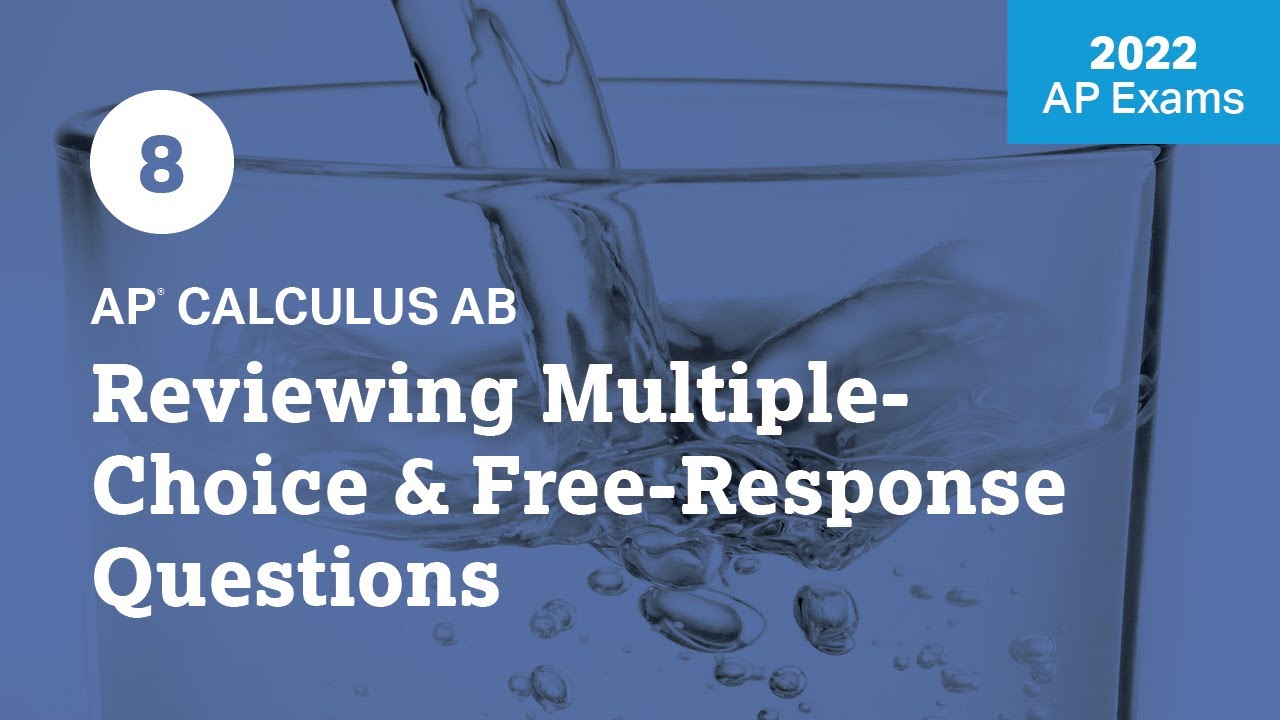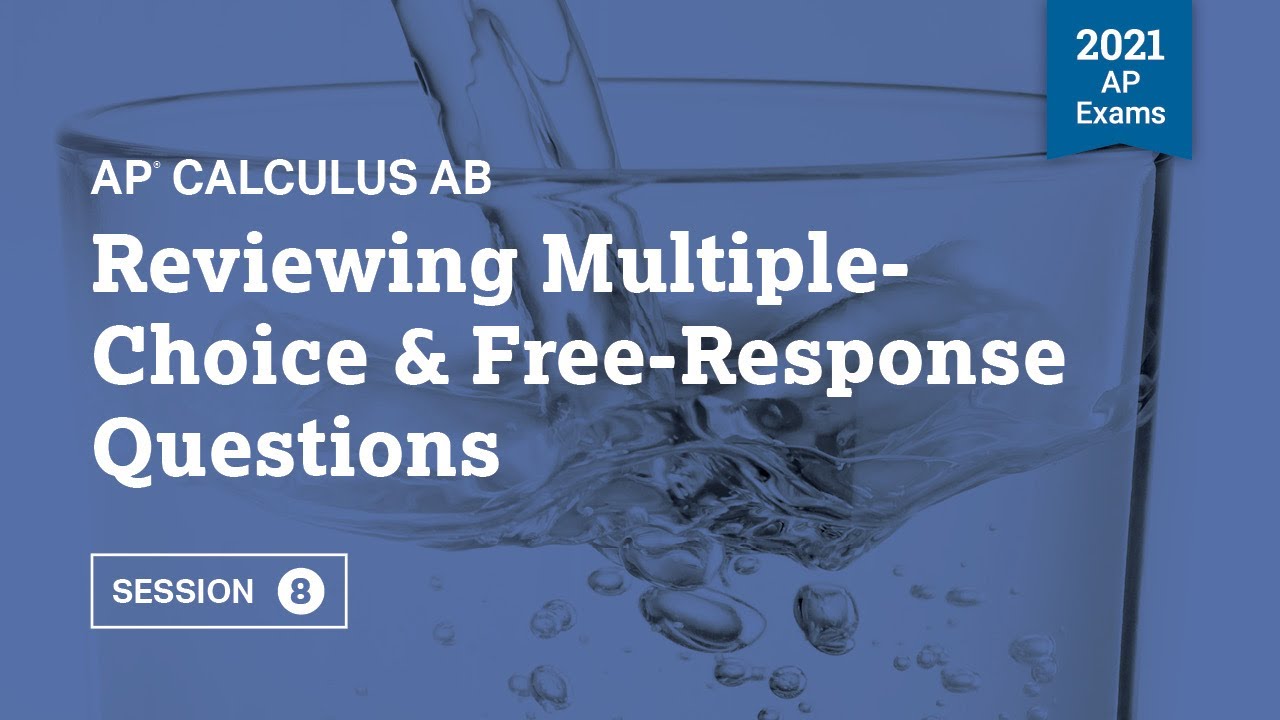2022 Live Review 1 | AP Calculus AB | Practicing with Derivatives & Chain Rule
TLDRThe video script is a comprehensive review session for the AP Calculus exam, led by educators Birch Bernoulli and Mark Crowley. They cover a range of calculus topics, emphasizing the importance of understanding and applying differentiation rules, including the product, quotient, and chain rules. The session includes a warm-up problem, a variety of multiple-choice questions, and a Q&A format that encourages student interaction. The instructors also discuss the format of the AP exam, offering strategies for tackling both multiple-choice and free-response questions. They provide a QR code for accessing practice problems and emphasize the significance of the exam, which is scheduled for May 9th. The session concludes with a recap of the day's learning objectives and a teaser for the next day's focus on related rates and applications of derivatives.
Takeaways
- 📚 Start with a review of basic differentiation rules, including the product rule, chain rule, and implicit differentiation.
- 📈 Understand that the AP Calculus exam requires knowledge of multiple representations, such as graphs and tables, along with calculus concepts.
- ✍️ Practice is essential; ensure to write down and memorize key calculus rules and formulas for quick reference during the exam.
- 🔗 Recognize that the exam format includes both multiple-choice and free-response sections, each requiring different strategies and time management.
- 📱 For the multiple-choice section, it's important to note that a calculator is not allowed for the first 30 questions, which should be practiced accordingly.
- ⏱ Time management is crucial; students generally find they have enough time to complete the multiple-choice section of the AP Calculus exam.
- 📐 Know how to apply derivatives in various contexts, such as finding the slope of a tangent line or understanding the instantaneous rate of change.
- 🧮 Be comfortable with different notations for derivatives, such as f'(x), ( \frac{dy}{dx} \u0029, or df/dx, which may be used interchangeably.
- 🔑 The product rule and chain rule are fundamental and will be repeatedly used throughout the AP Calculus exam.
- 📋 Maintain clear and organized handwriting while solving problems to avoid confusion and potential mistakes.
- 🚀 Aim to identify patterns in calculus problems, which can simplify complex tasks and save time, especially when dealing with higher-order derivatives.
Q & A
What is the main topic of the first day of reviewing for the AP Calculus exam?
-The main topic of the first day is derivatives, specifically focusing on basic differentiation rules, the chain rule, and implicit differentiation.
What is the role of the chain rule in calculus?
-The chain rule is used to compute the derivative of a composition of functions, where the derivative of the outer function times the derivative of the inner function is taken.
What does Birch Bernoulli suggest for students to do during the warm-up phase of the session?
-Birch Bernoulli suggests that students should have pens and paper or pencils and paper ready, and they might want to pause the video to actually do the warm-up exercises before rejoining the session.
What is the significance of practicing with multiple-choice questions in the context of AP exam preparation?
-Practicing with multiple-choice questions helps students get familiar with the format of the AP exam, which consists of both multiple-choice and free-response sections, and allows them to apply the content knowledge through the exam format.
How does Mark Crowley approach the problem of 3sin(x) using the chain rule?
-Mark approaches the problem by first recognizing the constant multiplier 3, then applying the chain rule to the sine function, which involves taking the derivative of sine (cosine) and multiplying it by the derivative of the argument (x), resulting in 3cos(x).
What is the purpose of the QR code mentioned in the transcript?
-The QR code is used to provide students with access to the practice problems that are being discussed during the session. Scanning the QR code allows students to download or view the problems and work on them.
What is the importance of writing down calculus rules such as the product rule?
-Writing down calculus rules helps students to memorize and quickly recall them during exams, ensuring that they can apply these rules accurately and efficiently to solve problems.
Why is it recommended to watch AP Classroom videos in addition to the review sessions?
-AP Classroom videos offer additional explanations and examples that can reinforce understanding of the material. They are a valuable resource that students can use to supplement their learning and preparation for the AP exam.
What does Birch Bernoulli suggest for students who are unsure about their algebraic steps?
-Birch Bernoulli suggests that students should be as careful as they need to be, taking as many shortcuts that make them feel comfortable, but also ensuring they understand the steps and don't skip essential parts of the process.
What is the strategy used by the presenters to solve the problem involving the derivative of y with respect to x, given y = x^3 - 2y - y^2 = -4?
-The presenters use implicit differentiation, applying the chain rule and power rule to find the derivative dy/dx, and then substituting given values to solve for dy/dx specifically.
What is the key takeaway for students regarding the AP Calculus exam preparation?
-The key takeaway is that understanding and practicing the foundational rules of derivatives is crucial for success on the AP Calculus exam. Students are encouraged to review these rules regularly and apply them in various contexts, including multiple-choice and free-response questions.
Outlines
😀 Introduction to AP Calculus Exam Review
The video begins with Birch Bernoulli and Mark Corelli introducing themselves and stating their experience with AP Calculus exam preparation. They are from different high schools in Texas and Mississippi, respectively. The session is the first of eight, focusing on calculus, specifically differentiation rules including the chain rule and basic differentiation. The presenters also mention that they will be looking at multiple-choice questions and provide a QR code for additional practice problems.
📚 Derivatives and Product Rule Application
The presenters work through a problem involving the derivative of a function composed of a constant multiplied by the sine function. They discuss the process of differentiating using the chain rule and the importance of recognizing constants. They also emphasize the value of writing down and memorizing differentiation rules, such as the product rule, for effective problem-solving.
🧐 Implicit Differentiation and Quotient Rule
The video continues with an example of implicit differentiation, where a relationship between x and y is given, and the derivative dy/dx is sought. The presenters use the chain rule to differentiate parts of the equation involving x and y. They also cover the quotient rule, applying it to a function with a numerator and denominator involving x, and evaluate the derivative at a specific point.
📈 Evaluating Derivatives at Specific Points
The discussion moves to evaluating derivatives at specific points, such as when x equals one. The presenters substitute the value into the derivative expression and simplify to find the value of the derivative at that point. They also caution about the importance of careful algebra and the use of clear handwriting to avoid mistakes.
🔢 Derivatives of Exponential and Power Functions
The video covers the derivatives of exponential functions, power functions, and the natural logarithm base. The presenters differentiate a function composed of multiple terms, each requiring different rules, such as the power rule and the chain rule. They also discuss the derivative of a function involving e to the power of a variable and the natural logarithm of the base.
🔁 Recognizing and Utilizing Patterns in Derivatives
The presenters explore the concept of higher-order derivatives, specifically the 19th derivative of a trigonometric function. They discuss the cyclical nature of the derivatives of trigonometric functions and how to recognize and use these patterns to simplify the process of finding higher-order derivatives. They also touch on the importance of evaluating these derivatives at specific points.
📚 Comprehensive Derivative Rules and Notations
The video emphasizes the importance of understanding and memorizing various derivative rules and notations. The presenters discuss the derivative of the second derivative, the use of different notations for derivatives, and the application of these rules in related rates and other calculus topics. They also mention the value of practicing these rules for the AP exam.
🔢 Derivatives of Composite Functions and Implicit Differentiation
The presenters work through problems involving the derivatives of composite functions and implicit differentiation. They apply the chain rule to functions involving nested structures and differentiate expressions involving inverse trigonometric functions. The process involves finding the derivative of the outer function times the derivative of the inner function.
📈 Applying Derivatives to Tangent Lines and Rates of Change
The video concludes with a discussion on the application of derivatives to find the slope of tangent lines and rates of change. The presenters differentiate functions to find the slope of the tangent line at specific points and discuss the importance of understanding what the derivative represents in various contexts. They also provide a joke related to calculus to lighten the mood.
📝 Recap and Expectations for Future Sessions
The presenters recap the key points covered in the session, including the importance of understanding derivative rules, the chain rule, and the application of derivatives in various contexts. They also outline what to expect in future sessions, such as related rates, tangent approximations, and linear approximations. The video ends with a reminder of the exam dates and a summary of the day's learning outcomes.
Mindmap
Keywords
💡AP Calculus Exam
💡Derivatives
💡Chain Rule
💡Implicit Differentiation
💡Product Rule
💡Quotient Rule
💡Multiple Choice Questions
💡Free Response Questions
💡Differentiation Rules
💡Exponential Functions
💡Trigonometric Functions
Highlights
Introduction to the first day of AP Calculus exam review with Birch Bernoulli and Mark Crowley.
Emphasis on practicing derivatives and the chain rule as a key concept in calculus.
Explanation of basic differentiation rules and the application of the chain rule to implicit differentiation.
The importance of using multiple representations including graphs and tables for understanding calculus problems.
A warm-up problem to engage the audience and encourage active participation.
Approach to solving a warm-up calculus problem step-by-step with a focus on the chain rule.
Availability of practice problems through a QR code scan for additional exercises beyond the session.
Explanation of the AP exam format, which includes multiple-choice and free-response sections.
Review of the product rule and quotient rule with examples, stressing the importance of understanding the underlying calculus concepts.
Discussion on the application of implicit differentiation and its relation to the chain rule.
Integration of humor and student engagement through the sharing of a math-related joke.
Explanation of higher-order derivatives and how to notate them, particularly focusing on the 19th derivative as an example.
Use of the unit circle and trigonometric identities to solve calculus problems involving trigonometric functions.
Differentiation of various functions, including exponential and power functions, and the application of the natural logarithm.
Advice on exam preparation, emphasizing the importance of understanding the rules of differentiation and practicing them.
Highlighting the availability of AP Classroom resources for additional practice and review.
Review of the derivative as a tool for determining the slope of a tangent line and its geometric interpretation.
Discussion on the application of derivatives in related rates, linear approximations, and other real-world scenarios.
Final review and recap of the key points covered in the session, including a reminder of the importance of foundational calculus rules.
Transcripts
Browse More Related Video

1 | MCQ | Practice Sessions | AP Calculus AB

2021 Live Review 1 | AP Calculus AB | Understanding Derivatives & Chain Rule

2022 Live Review 8 | AP Calculus AB | Reviewing Multiple-Choice & Free-Response Questions

2021 Live Review 8 | AP Calculus AB | Reviewing Multiple-Choice & Free-Response Questions

1 | MCQ | Practice Sessions | AP Calculus BC

8 | FRQ (No Calculator) | Practice Sessions | AP Calculus AB
5.0 / 5 (0 votes)
Thanks for rating: